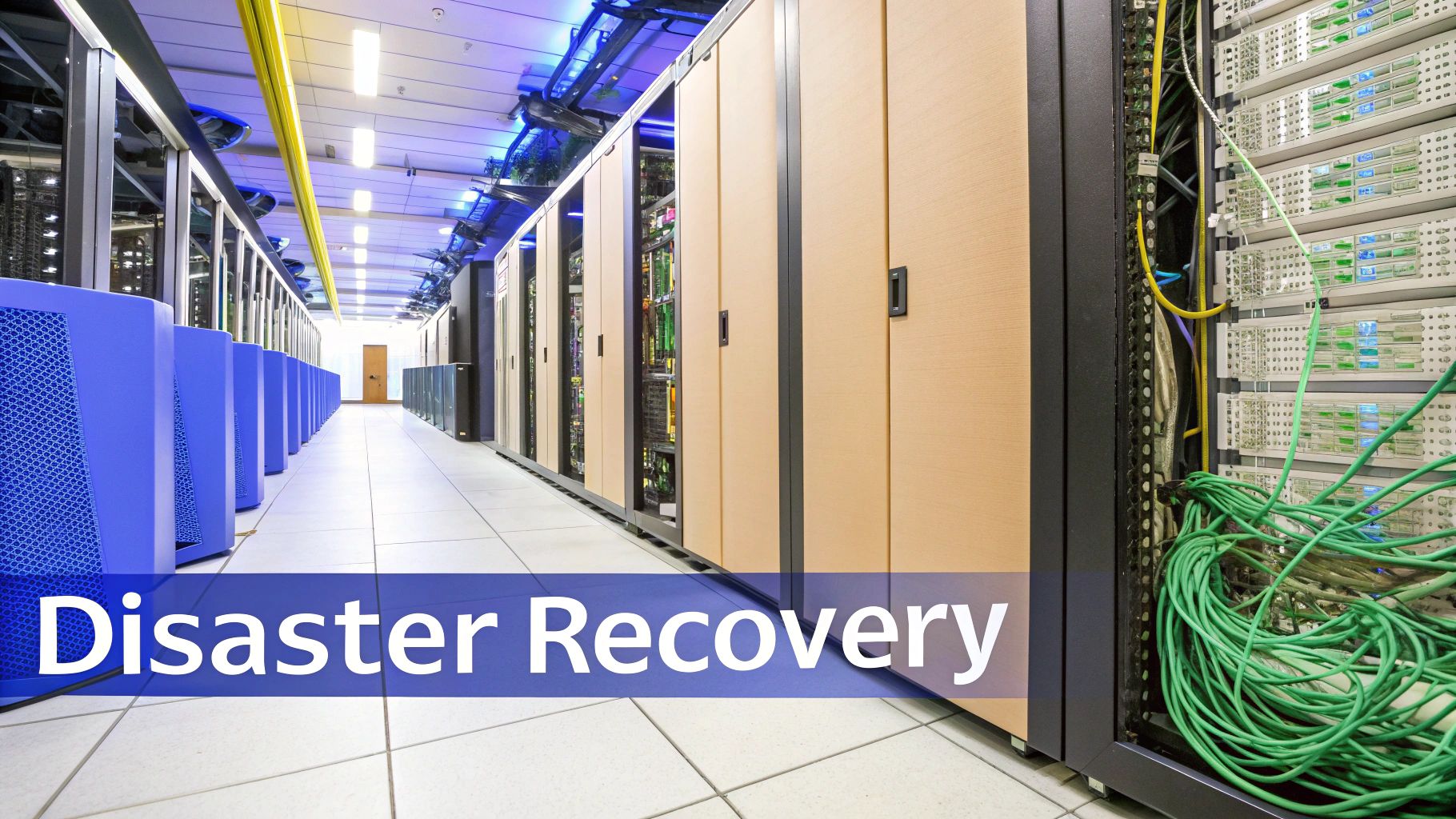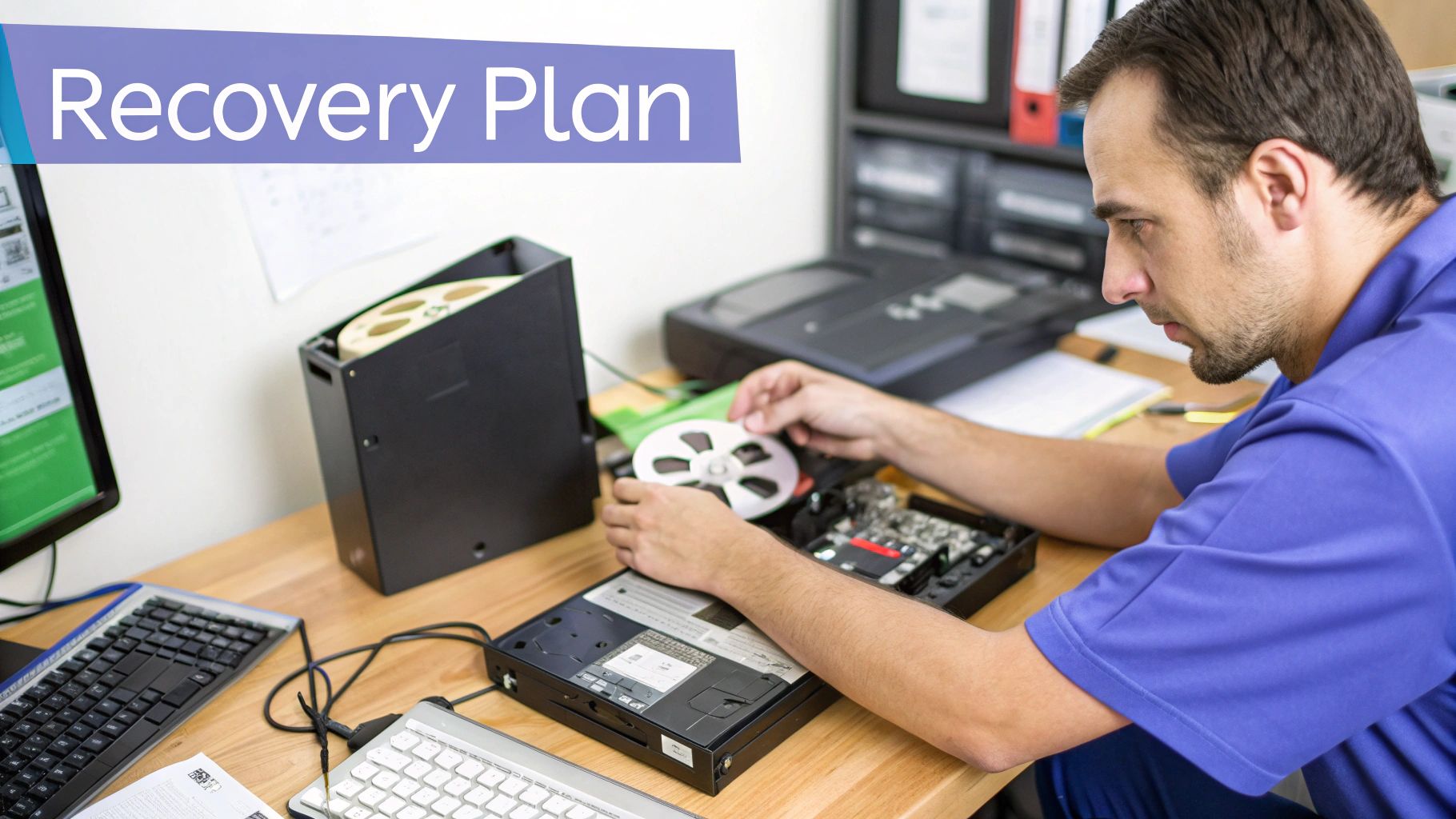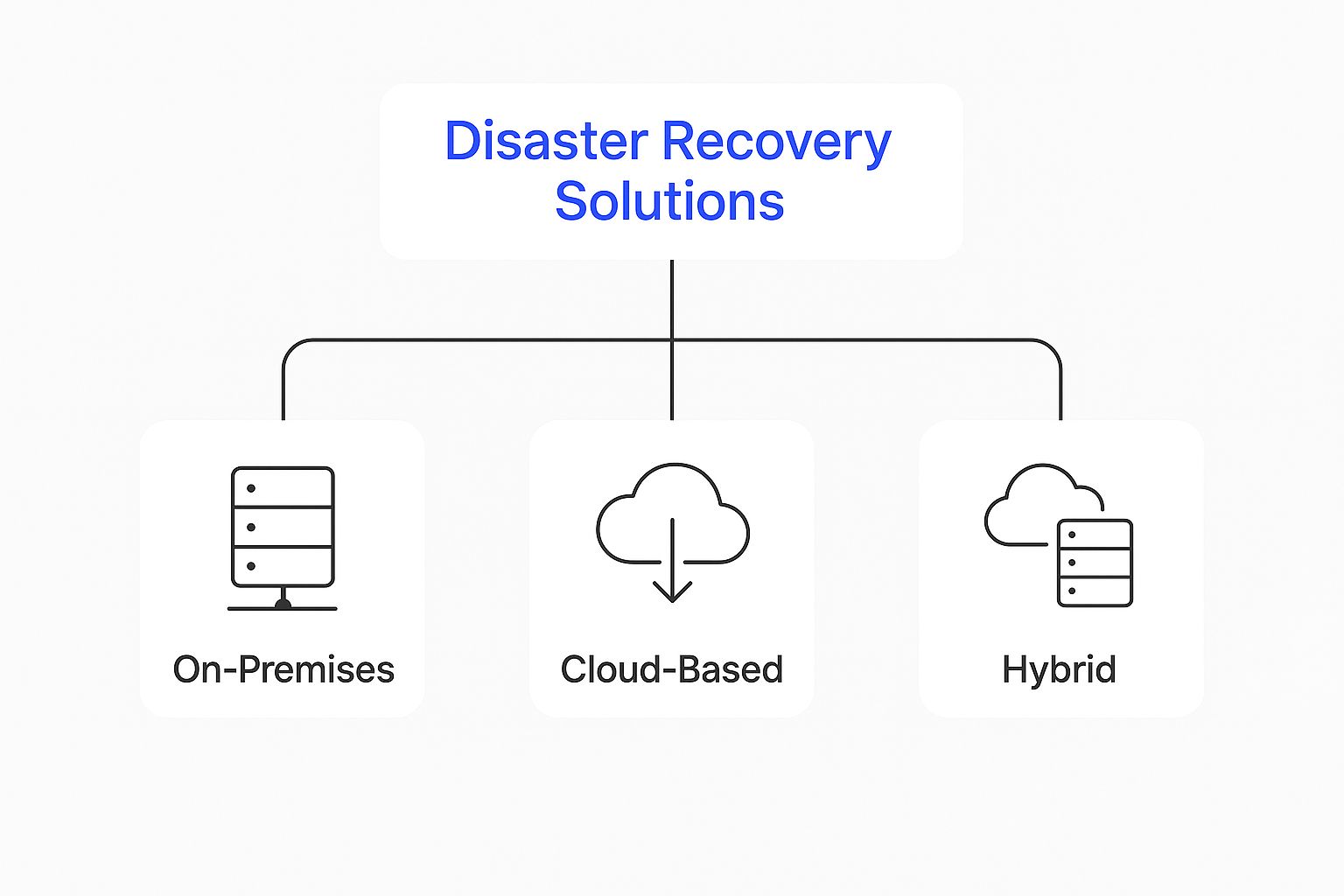What Is Disaster Recovery? Beyond The Tech Jargon

This screenshot from Wikipedia gives a general overview of disaster recovery. It highlights key areas like planning, strategies, and minimizing downtime. The graphic also shows how disaster recovery planning is a continuous cycle—an ongoing process crucial for any business, especially creative ones.
For UK creative businesses, disaster recovery means more than just getting back lost files. Imagine this: a major campaign for a big client, weeks of work, gone just days before launch. A nightmare, right? But it happens. This is why you need a solid disaster recovery plan. It's your safety net, keeping your business running even when things go sideways. Disaster recovery isn't just about the tech; it's about protecting your reputation, your client relationships, and your profits.
More Than Just Backups: Understanding True Business Continuity
Many UK creatives think regular backups are all they need. They’re not wrong, but backups are only one piece of the puzzle. Disaster recovery is much bigger. Think of it like this: backing up your files is like having a spare tire. Important, sure, but it won't do much if your engine blows up. Disaster recovery, however, is like having a whole other car ready and waiting. This means your entire creative process—project files, software, communication—can be restored quickly and efficiently.
Why Your Creative Workflow Needs Special Consideration
Creative agencies in the UK face unique challenges. Large project files, collaborative workflows, and tight deadlines make them more vulnerable. Losing access to a shared drive at a crucial moment, for example, can be devastating. And with more people working remotely, keeping data secure and accessible across different locations is even trickier. This is why a disaster recovery plan specifically designed for a modern creative workflow is so important.
Protecting Client Trust and Your Reputation
Client trust is everything for creative agencies. Losing data can seriously damage that trust and your reputation. Imagine having to tell a client their campaign assets are gone, and you can't get them back. That's not just a technical problem; it’s a huge breach of trust. A strong disaster recovery plan shows your clients you're serious about protecting their data and keeping things running smoothly, no matter what. It shows you’re professional and reliable, which is key in a competitive market. This builds confidence and strengthens client relationships—essential for long-term success in the UK's creative industry.
Why UK Creatives Face Unique Disaster Recovery Challenges

Creative agencies, particularly in the UK, face a specific set of vulnerabilities. Imagine juggling massive project files, intense team collaboration, and tight deadlines. Then, add the complexities of post-Brexit data regulations. This creates a situation that typical disaster recovery solutions often can't handle. A small design studio in Brighton has different needs than a large London agency managing global brands. They deal with different kinds of data, require different levels of security, and experience vastly different impacts from downtime.
The Impact of Remote Work and Collaboration
The move to remote work has amplified these vulnerabilities. A freelancer in Edinburgh working from home doesn't have the same IT setup as a studio in Soho. Yet, both depend heavily on digital assets and smooth workflows. This reliance increases the impact of data loss, whether from a simple hardware failure or a complex cyberattack. The vulnerability of small and medium-sized enterprises (SMEs) to disasters is a real concern. About 40% of SMEs never reopen after a natural catastrophe, and another 25% reopen only to close within a year. This isn't unique to the UK, but it highlights the need for strong disaster recovery plans, especially given the UK’s unique challenges like Brexit-related data rules. Discover more insights about disaster recovery statistics.
Data Sovereignty in a Post-Brexit World
Post-Brexit data regulations add another layer of complexity for UK creatives. Working with international clients or EU-based partners requires careful thought about data storage and access. A London agency collaborating with a photographer in Paris needs a disaster recovery plan that considers these cross-border data flows while complying with GDPR and other regulations. This is not just about following rules; it's about maintaining client trust and ensuring smooth collaboration across locations.
The Real Cost of Downtime for Creatives
Downtime for a creative business isn't just an inconvenience; it's a financial hit. Missed deadlines, lost productivity, and potential contract penalties add up quickly. Imagine a video editing studio losing project files during post-production. The financial impact can be devastating. Understanding disaster recovery is crucial for UK creatives. It's about reducing these risks and ensuring business continuity when unexpected events occur.
The Booming UK Market and What It Means for Your Agency

The UK's creative scene is thriving. More clients, exciting projects, and sophisticated digital tools are everywhere. But this growth brings new challenges. Think of it like building a taller house – the higher you go, the stronger the foundation needs to be.
More projects mean more data. More data means more reliance on technology. And more reliance on technology? That means you're more exposed if something goes wrong. This is why disaster recovery is so crucial in the UK right now. It's not a passing fad; it's a necessity for agencies like yours.
Cybersecurity and the Creative Industry: A Growing Threat
One of the biggest reasons for this growing need is the increase in cyberattacks. Creative agencies are often targeted because they hold valuable intellectual property, the lifeblood of any creative business. Imagine a ransomware attack locking down your client's campaign assets just days before launch. The damage to your reputation and your bottom line could be devastating. Suddenly, understanding disaster recovery isn't just about technical details – it's about survival.
The Cloud: Both a Solution and a Challenge
Cloud-based tools like Adobe Creative Cloud are essential for modern agencies. They allow for flexible working, easy collaboration, and access to powerful software. But this convenience has a flip side: relying on the cloud also means relying on someone else's security. This added complexity makes a solid disaster recovery plan even more important.
This isn't just theory; the market shows us this need is real. The UK disaster recovery as a service market was valued at USD 356.18 million in 2024. It's expected to grow at a CAGR of 25.30% from 2025 to 2033. This growth reflects the very real threat landscape UK agencies face. You can find more details about the UK disaster recovery market here.
Cost Implications and Evaluating Your Current Setup
Different disaster recovery options come with different price tags. A simple backup is cheaper than a fully redundant system, but it won't offer the same level of protection. Think of it like insurance – a basic policy is less expensive than a comprehensive one, but it covers less.
As a UK creative agency, you need to weigh the cost of downtime against the investment in disaster recovery. Ask yourself: can your current setup handle a major data loss? Could you keep your business running during a crisis? These are the questions you need to answer now, not after disaster strikes.
Navigating Post-Brexit Data Rules For Creative Agencies
Brexit has undeniably reshaped the business landscape, and many UK creative agencies are still finding their footing, especially when it comes to disaster recovery. If your agency stores client brand assets, collaborates internationally, or works with EU partners, data sovereignty isn't just a box to tick on a compliance checklist—it's crucial for your business's survival. Let's break down how post-Brexit disaster recovery affects UK creative businesses.
Understanding Data Sovereignty and Its Impact
Think of data sovereignty as the legal address of your data. It's about where your data lives and which country's laws apply to it. After Brexit, moving data between the UK and EU became subject to new regulations. For creative agencies, this means you need to know exactly where your client data is stored, how it's backed up, and whether your disaster recovery plan follows these rules.
Imagine a London-based agency with servers in Dublin. Brexit changed the game for accessing that data in a crisis. That's why adapting your disaster recovery approach is so important.
Real Risks of Non-Compliance For UK Creatives
Ignoring these regulations isn't just a minor inconvenience—the consequences can be serious. Non-compliance can lead to significant fines and damage your agency's reputation. Imagine losing client trust due to a data breach caused by a faulty disaster recovery process. For creative businesses built on reputation and client relationships, this could be a fatal blow. Legal battles and operational disruptions due to non-compliance can also drain your resources and bring projects to a standstill.
This is particularly important for agencies handling sensitive data. For instance, a healthcare marketing agency in Manchester must ensure patient data complies with both UK and EU data protection laws, even during a disaster recovery situation. This adds another layer of complexity that requires careful planning and execution.
The UK disaster recovery as a service market is also being shaped by these post-Brexit concerns. Companies are actively seeking solutions that keep data within UK borders. This demand is a key driver as businesses adapt to new data regulations. Learn more about the growing UK disaster recovery market here.
Practical Strategies For Post-Brexit Disaster Recovery
So, what's a UK creative agency to do? First, take stock of where your data is stored and how it travels between the UK and EU. Next, review your current disaster recovery plan. Does it take these new data boundaries into account? Consider these practical steps:
-
Data Mapping: Create a clear record of where all client data is located and how it's accessed.
-
Localising Data: Think about storing EU client data within the EU to simplify compliance.
-
Updating Contracts: Make sure your client contracts reflect your updated post-Brexit data handling procedures.
-
Expert Advice: Consult with legal and IT professionals to ensure you're meeting all the requirements.
By taking these steps, UK creative agencies can navigate the post-Brexit world while maintaining business continuity and client trust. This proactive approach strengthens your agency's resilience and shows your commitment to data security in a constantly changing regulatory environment.
Building Your Creative Agency's Recovery Strategy That Actually Works
A truly effective disaster recovery plan for a UK creative agency isn't about buying the priciest software. It's about building a system that works when things go sideways—especially when everything else is falling apart. Imagine a server crash right as you launch a major campaign. Your work disappears, deadlines are breathing down your neck, and clients are understandably on edge. This section gives you the tools to handle such a crisis, outlining the essentials of a robust disaster recovery plan built for the creative world.
Understanding Your Vulnerabilities and Prioritizing Recovery
Before looking at solutions, take an honest look at your agency's weaknesses. What would happen if you lost key assets like client project files, design software licenses, or internal communication platforms? Which loss would hit you hardest? A small animation studio, for instance, might prioritize recovering its animation software and project files over email access, while a PR agency might prioritize client contact lists and press releases.
The infographic below visualizes different disaster recovery approaches: on-premises, cloud-based, and hybrid. Each has its own pros and cons, highlighting the importance of picking the right one for your agency's specific needs.

As the infographic shows, disaster recovery solutions come in various forms, each with its own balance of control, cost, and complexity. The best fit depends heavily on your specific needs and resources. Understanding your agency’s unique vulnerabilities is crucial for building a truly effective recovery plan.
Prioritization is essential. Not all data is equally important. Critical client projects need higher priority and faster recovery than internal admin files. This brings us to Recovery Time Objective (RTO)—the maximum acceptable downtime for each system or asset. Your main project server might have a 24-hour RTO, meaning you aim to restore it within a day, while your email system might have a 48-hour RTO.
To help visualize this, let's look at a practical example of how different assets might be prioritized.
The following table outlines a Disaster Recovery Priority Matrix specifically designed for creative agencies. It compares various creative assets and business functions, ranked by recovery priority and time sensitivity.
Disaster Recovery Priority Matrix For Creative Agencies
| Asset/Function | Recovery Priority | Maximum Downtime | Impact Level | Recovery Method |
|---|---|---|---|---|
| Client Project Files | High | 24 hours | Critical | Cloud Backup/Local NAS |
| Design Software Licenses | High | 48 hours | High | Cloud Subscription/Backup Licenses |
| Internal Communication Platforms | Medium | 72 hours | Medium | Cloud-based Platform/Redundant System |
| Website | High | 24 hours | High | Cloud Backup/Secondary Hosting |
| Financial Records | High | 72 hours | High | Cloud Backup/Offsite Storage |
| Marketing Materials | Low | 1 week | Low | Cloud Storage |
This matrix demonstrates that client files and website access, crucial for ongoing projects and client communication, require the fastest recovery times. Software licenses are also vital for productivity, while other functions can tolerate slightly longer downtime. This type of matrix is a powerful tool for making informed decisions about resource allocation and recovery procedures.
Practical Steps: Building Your Recovery Plan
Now, let’s turn these principles into action. A solid disaster recovery plan combines automated systems with clear manual processes.
-
Automated Backups: Regularly back up all essential data. Cloud-based solutions like Dropbox or Google Drive offer automated backups and offsite storage, protecting you from physical disasters like fires or floods.
-
Software Redundancy: Consider subscribing to cloud-based software like Adobe Creative Cloud or keeping backup licenses for critical design and editing applications. This keeps your team working even if local machines are down.
-
Communication Protocols: Set up clear communication channels for emergencies. Choose a point person to coordinate internal communication and client updates during a crisis. A dedicated messaging app like Slack or a cloud-based platform like Microsoft Teams can be invaluable. For more on building business resilience, check out our guide on proactive cybersecurity.
-
Documentation: Document every process, from backups to emergency contacts. Clear documentation helps your team act quickly and effectively, even under pressure. Review and update this documentation regularly as your systems and personnel change.
-
Testing: Regular testing is key. A disaster recovery plan is useless if it doesn't work when you need it. Schedule regular tests simulating various scenarios to find weaknesses and refine your procedures. This makes your plan a living system, ready to protect your creative agency when it matters most.
From Planning To Action: Making It Work Under Pressure
A well-crafted disaster recovery plan is like a fire drill – it's only useful if you actually know how to execute it. When things go sideways and clients are on edge, a dusty document isn't going to save the day. This section explores the practical side of disaster recovery: transforming your plan from theory into action. This means regular testing, team training, and procedures that work when the pressure's on.
Real-World Disaster Scenarios for UK Creatives
Imagine a ransomware attack locking down your Bristol design studio’s files just days before a major deadline. Or picture a flood wiping out the servers of a London advertising agency. These aren’t just hypothetical situations; they’re real risks UK creative agencies face every day. Different crises demand different responses. A cyberattack requires a different playbook than a physical disaster, but both need a well-rehearsed plan.
For instance, a ransomware attack might involve isolating affected systems, activating backups, and possibly negotiating with the attackers (although this isn't always recommended). A flood, however, means securing physical assets, finding a temporary workspace, and contacting insurance providers. Each disaster requires a unique, immediate response, underscoring the importance of preparation. You might find these 10 tips to help small businesses get ready for the unexpected helpful.
Actionable Procedures: From Panic to Productivity
So, how do you develop procedures that actually function when everyone is stressed?
-
Clear Roles and Responsibilities: Establish who does what in a crisis. Having someone specifically in charge of communication, data recovery, and client liaison prevents confusion and ensures a faster response. Think of a small design studio: perhaps the lead designer manages data recovery while the project manager updates clients.
-
Step-by-Step Instructions: Simplify complex processes into clear, actionable steps. Think checklists, flowcharts, and contact lists readily accessible both digitally and physically. These provide a roadmap through the chaos.
-
Regular Training and Drills: Practice really does make perfect. Regular disaster recovery drills with your team, simulating various disaster scenarios, help identify weaknesses and build confidence. Think of a mock ransomware attack: team members practice isolating systems and restoring from backups.
The Importance of Testing and Documentation
Imagine painstakingly creating a disaster recovery plan, only to find it falls apart during a real emergency. Regular testing is your safety net. It uncovers weaknesses, verifies your backups are working, and familiarizes your team with their roles, turning theory into practice.
Thorough documentation is equally important. A well-documented plan guides your team through recovery, even if key people are unavailable. Imagine a fire forcing your team to evacuate. Detailed documentation ensures anyone can find critical information like backup locations, contact details, and recovery steps, reducing downtime and preventing panic.
Growing With Your Business: Adapting Your Disaster Recovery
Your disaster recovery plan isn't a set-it-and-forget-it deal; it’s a living system that evolves with your business. As your agency grows, expands, or adopts new technologies, your disaster recovery strategy must adapt too. This involves reviewing your plan regularly, updating procedures, and conducting consistent training.
For a growing creative agency in the UK, this might mean scaling up backup systems as data grows or strengthening security when handling sensitive client information. This proactive approach keeps your disaster recovery robust and relevant, providing the protection your agency needs in a constantly shifting environment. The importance of disaster recovery for UK creative businesses cannot be overstated. It's not just about tech; it's about protecting your reputation, your client relationships, and your future.
To help you stay on track, consider the following testing schedule:
Disaster Recovery Testing Schedule For Creative Agencies
A comprehensive testing timeline showing what to test, when, and how to ensure your disaster recovery plan actually works
| Test Type | Frequency | Duration | Key Participants | Success Criteria |
|---|---|---|---|---|
| Backup Restoration | Monthly | 2-4 hours | IT, Design Lead | Successful restoration of critical files within the RTO |
| Ransomware Simulation | Quarterly | 4-8 hours | IT, Project Manager | Successful isolation of infected systems and restoration from backups |
| Fire Drill/Evacuation | Annually | 1-2 hours | All Staff | Orderly evacuation and verification of emergency contact procedures |
| Full Disaster Recovery Test | Annually | 1-2 days | IT, Senior Management, Key Department Heads | Successful failover to secondary systems and restoration of all critical functions within the RPO |
This table provides a basic framework. You'll need to customize it based on your specific needs, risks, and resources. Regularly reviewing and updating this schedule is crucial for ensuring your plan remains effective.
By following this schedule and adapting it to your agency's specific circumstances, you can be confident that your disaster recovery plan is more than just a document – it's a working system that will protect your business when it matters most.
Real Stories From UK Creative Agencies Who Survived Disaster
Learning from others' experiences, both good and bad, is priceless when creating your own disaster recovery plan. This section explores real-life situations faced by UK creative agencies, from cyberattacks threatening confidential client work to physical disasters destroying years of creative archives. These aren't just success stories, but honest accounts of what went wrong, what saved them, and the important lessons they learned.
The Ransomware Attack That Almost Crippled a London Design Studio
Picture this: it's Friday afternoon, and a London design studio's servers are suddenly locked by ransomware. All their current projects, client assets, everything—encrypted. Deadlines are looming on Monday, and their reputation is at stake. Luckily, they had backups, but restoring them was a race against time. This incident revealed a serious weakness: their backups weren't tested regularly. They recovered, but lost precious time and dealt with stressed clients. The key takeaway? Regularly test your backups. Just having them isn't enough; you need to know they'll actually work.
The Flood That Tested a Brighton Animation Studio's Resilience
Disaster struck a Brighton-based animation studio in the form of a burst water pipe. The studio, located in a converted basement, was flooded, damaging equipment and threatening years of work. Fortunately, they had already started using cloud storage for their project files. While they lost some hardware, their vital creative work was safe. This experience solidified the value of offsite backups and cloud solutions, particularly for smaller studios where physical locations can be vulnerable. They learned a tough lesson about diversifying their storage strategy.
The Server Crash That Exposed a Manchester Agency's Weakness
A Manchester marketing agency lived through every business's nightmare: a complete server crash during a major campaign launch. They had backups, but the restoration process was slow and painful. The incident exposed their reliance on a single point of failure. The outage harmed client relationships and showed the need for redundant systems. They invested in a secondary server and improved their recovery process, ensuring a faster response to future problems. This shows the vital importance of truly understanding what disaster recovery is and putting it into practice, not just having it in theory.
Learning From Others: Building Your Agency’s Resilience
These stories show the human side of disaster recovery. They highlight the importance of planning, testing, and adapting. They also show the difference between having a disaster recovery plan on paper and having one that works under pressure. By 2030, the disaster recovery market is expected to reach USD 4,453.6 million, showing the growing importance of business continuity in every industry. Learn more about the UK disaster recovery market here. You might also find this information on cybersecurity readiness for 2025 helpful. These agencies learned valuable lessons the hard way. By learning from their experiences, you can strengthen your own disaster recovery plan and protect your creative business from the unexpected.
Are you ready to protect your creative business from disaster? InfraZen helps UK creative agencies like yours build strong, reliable IT systems designed to withstand the unexpected. We understand the specific difficulties creative agencies face and offer solutions tailored to your creative workflow. Visit InfraZen today to learn how we can help you focus on your strengths—creating—while we handle the complexities of keeping your business safe and running smoothly.

